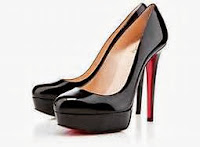When a woman wears high heels, she is
making a statement of daring proportions. She exudes poised
self-assurance and she flaunts femininity and fashion. She
confidently saunters like a moving picture of womanliness as her heels lengthen
her legs and emphasize particularly feminine aspects of each step.
Unfortunately, if her high heel wearing habits are frequent, she may be
activating unintentional devastation to her body. Steady high heel wearing can
cause a myriad of problems including, but not limited to, bunions, hammertoes,
lower back discomfort, inflamed nerves, and stretched tendons. Utilizing these
simple exercises can help alleviate issues like these that may arise. Let’s face it – we don’t want to ditch our
Manolos and Louboutins!
Strong and sturdy ankles are a critical
aspect of successful high heel wearing. Solid ankle strength helps you maintain
your balance. Walking on your tiptoes is an effortless way to build strength in
the ankles. Moving your ankles in circles in both directions is another
painless exercise to try (like we do in Pilates class!). Squats on the heels are
also beneficial.
Abdominals
Wearing high heels lifts your body from
its natural state, opposing its sense of equilibrium. This pushes the body to
overcompensate and forces muscles to work harder than they would typically to
maintain that upright position. This overcompensation can lead to lower back
troubles. Utilizing yoga poses that place you on one leg can combat that. To
maintain maximum comfort after spending extended periods of time in high heels, exercises that strengthen your abdominals like sit ups
and crunches can also be quite helpful (again a lot of the core work that we
practice in Pilates).
Calves
While constantly moving about in high
heels builds up calf muscles, the elevated position of the heel in the shoes
actually shortens the Achilles tendon. Because of this, your calf muscles may
become weakened when you aren’t wearing heels. Simple calf stretches can be
done by leaning into a wall or by utilizing the standard Downward Dog position
of traditional yoga to avoid issues with these muscles.
Heels
With the comfort, popularity, and
handiness of flats, many high heel wearers will change from heels to flatter
shoes upon reaching a destination or in transit. While the short term comfort
of this makes your weary feet sigh in relief, frequently switching between
flats and high heels can lead to inflammation of the Achilles tendon. Irritation
of this tissue that connects the heel to the calf muscle leads to painful
tendonitis, a condition that can visibly be characterized as a swollen and
tender lump above the heels. Hanging your heels off of a step while standing on
it, and rising up and down on your toes is an excellent way to stretch the
Achilles tendon. Also, wearing flat
shoes that have a slight wedge and/or straps and laces will support the foot in
a much better fashion.
Many thanks to Virginia K. who submitted this article for our reading pleasure!

No comments:
Post a Comment